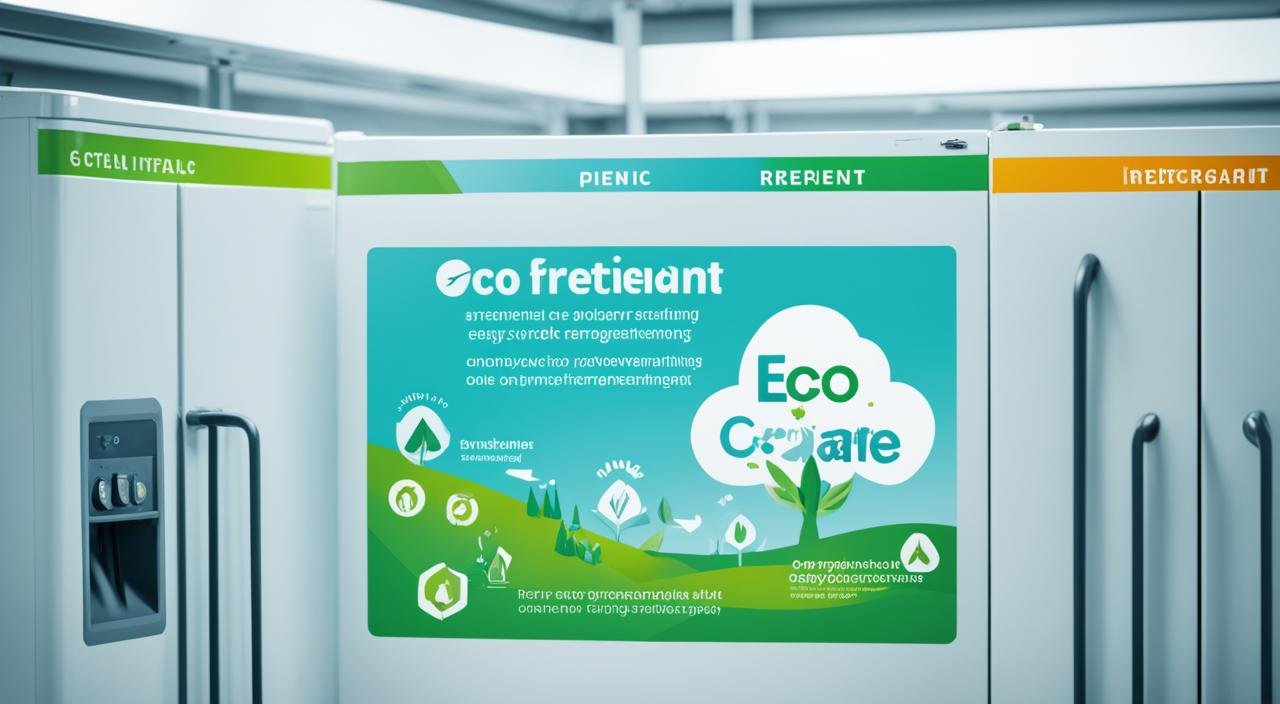In today’s world, the importance of eco-friendly living and sustainable choices cannot be overstated. But what exactly does it mean to be eco-friendly? How can we live in a way that is environmentally friendly and preserves our planet? In this guide, I will provide you with a comprehensive eco-friendly definition and explore the principles and examples of sustainable living.
Eco-friendly, or environmentally friendly, refers to living in a way that minimizes harm to the environment. It involves making conscious decisions and adopting practices that reduce our carbon footprint and negative impact on the planet. Sustainable living, on the other hand, takes eco-friendliness a step further. It aims for a balance between meeting our needs and preserving the environment for future generations.
Sustainable living encompasses three pillars: environmental, social, and economical. It is not just about reducing waste and conserving energy, but also about promoting social equity and economic stability. By considering the impact our choices have on these three areas, we can create a more sustainable and harmonious world.
There are countless examples of eco-friendly practices that can be incorporated into our daily lives. From conserving energy and transitioning to renewable sources, to reducing waste and supporting local businesses, each small step adds up to make a significant difference. It’s about making choices that have a positive impact on the environment and promote a more sustainable future.
Key Takeaways:
- Eco-friendly, or environmentally friendly, living means minimizing harm to the environment through conscious decision-making.
- Sustainable living aims for a balance between meeting our needs and preserving the environment for future generations.
- Sustainable living encompasses environmental, social, and economical pillars.
- Examples of eco-friendly practices include conserving energy, transitioning to renewable sources, reducing waste, and supporting local businesses.
- Each small step towards sustainable living contributes to a more eco-friendly future.
The Importance of Sustainable Living
Sustainable living is crucial for several reasons. First, it helps preserve the planet for future generations by reducing our impact on the environment. It also promotes resource efficiency and reduces reliance on fossil fuels, helping to curb climate change. Sustainable living encourages healthier habits, such as cycling and organic food consumption, which have positive impacts on both individual and planetary health. Ultimately, it is a moral responsibility to take care of our planet and its resources, and sustainable living is the most effective way to achieve this.
| Benefits of Sustainable Living | Examples |
|---|---|
| Preserve the planet for future generations | Growing one’s own food |
| Promote resource efficiency | Transitioning to renewable energy |
| Reduce reliance on fossil fuels | Choosing recyclable options |
| Improve individual and planetary health | Shopping locally |
| Moral responsibility to take care of the planet | Composting |
Sustainable Living vs. Zero-Waste Living
While sustainable living and zero-waste living share some similarities, they are different concepts. Zero-waste living focuses on minimizing waste generation and utilizing reusable and compostable alternatives. It aims to create as little waste as possible. On the other hand, sustainable living goes beyond waste reduction and encompasses a broader range of environmentally conscious choices, such as energy conservation, local and organic food consumption, and transportation habits. It seeks to create a balance between meeting human needs and preserving the planet.
To better understand the similarities and differences between sustainable living and zero-waste living, let’s take a closer look:
Sustainable Living
Sustainable living is a holistic approach that encompasses various aspects of our lives, including energy consumption, waste management, and lifestyle choices. It aims to minimize our ecological footprint and promote the long-term well-being of both people and the planet. Key components of sustainable living include:
- Energy conservation: This involves reducing energy consumption by adopting energy-efficient practices and utilizing renewable energy sources such as solar or wind power.
- Resource conservation: Sustainable living encourages the responsible use of natural resources and the promotion of sustainable practices, such as recycling and water conservation.
- Local and organic food consumption: Supporting local farmers and opting for organic produce reduces carbon emissions associated with long-distance transportation and promotes healthier food choices.
- Transportation habits: Choosing eco-friendly transportation options like walking, cycling, or using public transit helps reduce reliance on fossil fuels and lowers greenhouse gas emissions.
The goal of sustainable living is to create a harmonious balance between meeting our present needs while ensuring the well-being of future generations and the planet.
Zero-Waste Living
Zero-waste living is a lifestyle that aims to minimize waste generation and send as little waste as possible to landfills or incinerators. It involves making conscious choices to reduce, reuse, and recycle. Key aspects of zero-waste living include:
- Waste reduction: Zero-waste living focuses on reducing the amount of waste produced by avoiding single-use items, choosing products with minimal packaging, and adopting reusable alternatives.
- Composting: Composting organic waste helps divert it from the landfill and allows it to be transformed into valuable soil amendment.
- Recycling: Maximize recycling efforts by properly sorting recyclable materials and supporting local recycling programs.
Zero-waste living aims to create a closed-loop system where resources are used efficiently, waste is minimized, and materials are recycled or repurposed whenever possible.
Here’s a table summarizing the similarities and differences between sustainable living and zero-waste living:
| Sustainable Living | Zero-Waste Living | |
|---|---|---|
| Main Focus | Environmentally conscious choices in various aspects of life, including energy consumption, waste management, and lifestyle choices. | Minimizing waste generation and utilizing reusable and compostable alternatives. |
| Components | Energy conservation, resource conservation, local and organic food consumption, transportation habits. | Waste reduction, composting, recycling. |
| Goal | Creating a balance between meeting human needs and preserving the planet in the long run. | Minimizing waste generation and moving towards a closed-loop system. |
“The greatest threat to our planet is the belief that someone else will save it.” – Robert Swan
By adopting both sustainable living and zero-waste living practices, individuals can make a significant positive impact on the environment and contribute to a more sustainable future.
Going Green on a Larger Scale
While sustainable living is important for individuals, businesses and governments also play a significant role in environmental conservation. Businesses have the power to make a positive impact by adopting green practices in their operations, product manufacturing, and packaging.
“Sustainable practices and environmentally friendly choices not only benefit the planet but also lead to customer loyalty and increased profitability.
Businesses can support sustainable living by offering green products and services that prioritize environmental sustainability. For example, companies can use recyclable or biodegradable packaging materials, source raw materials from sustainable suppliers, and promote energy conservation in their facilities. By implementing these green practices, businesses contribute to reducing carbon emissions, minimizing waste, and preserving natural resources.
Moreover, governments have the power to drive change through policy implementation. They can incentivize sustainable living by offering tax breaks and financial benefits to eco-friendly businesses. Governments can also pass laws and regulations that ban single-use plastics, promote renewable energy usage, and enforce sustainable practices in various industries.
“Incentivizing businesses to adopt sustainable practices and creating laws that protect the environment are crucial steps towards collective environmental conservation.”
Collectively, the choices made by individuals, businesses, and governments have a profound collective impact on the environment. By embracing green practices, we can achieve significant progress in sustaining the planet for future generations.
Green Practices for Businesses and Governments
| Green Practices for Businesses | Green Practices for Governments |
|---|---|
| Using sustainable materials | Implementing policies that incentivize eco-friendly businesses |
| Adopting renewable energy sources | Enforcing laws to ban single-use plastics |
| Minimizing waste generation | Promoting renewable energy usage |
| Supporting local and sustainable suppliers | Creating initiatives to conserve natural resources |
| Optimizing energy consumption | Offering tax breaks and financial benefits to eco-friendly businesses |
By prioritizing green practices and working together, we can ensure a sustainable and environmentally conscious future for all.
The Benefits of Green Living
Green living offers a wide range of benefits that not only contribute to a cleaner and healthier environment but also bring positive changes to our lives and communities. By adopting sustainable choices, we can make a tremendous impact on pollution reduction, resource preservation, economic savings, improved health, and community well-being.
Pollution Reduction
One of the significant benefits of green living is its contribution to pollution reduction. By embracing eco-friendly practices, such as conserving energy, reducing waste, and using renewable resources, we can minimize harmful emissions and pollutants, creating a cleaner and healthier environment for ourselves and future generations.
Resource Preservation
Green living also plays a vital role in preserving our natural resources. By making sustainable choices, such as recycling, reusing, and opting for products made from renewable materials, we can reduce the strain on our planet’s resources. This helps ensure that these resources will be available for future generations to enjoy and benefit from.
Economic Savings
Adopting a green lifestyle can lead to significant economic savings. By reducing energy consumption, choosing energy-efficient appliances, and implementing eco-friendly practices, we can lower our utility bills. Additionally, supporting the green market, which offers affordable and sustainable alternatives, allows us to make cost-effective choices without sacrificing quality or style.
Improved Health
Green living promotes improved health for both individuals and communities. By choosing organic and locally sourced food, we reduce our exposure to pesticides and support sustainable agriculture. Additionally, the use of eco-friendly products and materials reduces our exposure to harmful chemicals, promoting a healthier living environment for ourselves and our loved ones.
Community Impact
When we adopt a green lifestyle, our actions can have a ripple effect within our communities. Our sustainable choices inspire others to follow suit, creating a positive community impact. From organizing neighborhood cleanups to initiating recycling programs, green living fosters a sense of community and collective responsibility for creating a sustainable future.
| Benefits of Green Living | Description |
|---|---|
| Pollution Reduction | By reducing harmful emissions and pollutants through sustainable practices, we contribute to cleaner air and water. |
| Resource Preservation | Green living helps preserve our planet’s natural resources, ensuring their availability for future generations. |
| Economic Savings | By reducing energy consumption and supporting the green market, we can save money on utility bills and affordable, sustainable products. |
| Improved Health | Green living promotes healthier choices, such as organic food consumption and the use of eco-friendly products, leading to improved well-being. |
| Community Impact | Adopting a green lifestyle inspires and creates a positive impact within our communities, fostering a collective commitment to sustainability. |
By embracing green living, we not only benefit ourselves but also contribute to a sustainable future for generations to come. With each eco-friendly choice we make, we move towards a healthier planet, reduced pollution, and a brighter future. Let’s embrace the benefits of green living and inspire others to join us on this transformative journey.
Examples of Green Living
When it comes to incorporating green living into your daily life, there are endless possibilities. By making conscious choices, you can contribute to a more sustainable future. Here are some examples of green living practices that you can implement:
Renewable Energy
Utilize renewable energy sources such as solar panels to power your home or workplace. By harnessing the power of the sun, you can reduce your reliance on fossil fuels and decrease carbon emissions.
Public Transportation
Opt for public transportation or walking whenever possible. By reducing the use of private vehicles, you can help minimize air pollution and congestion while also saving money on fuel.
Reducing Meat Consumption
Eating less meat or embracing a plant-based diet can significantly reduce your environmental footprint. Animal agriculture is a major contributor to greenhouse gas emissions, deforestation, and water pollution. By choosing plant-based alternatives, you can contribute to a more sustainable food system.
Sustainable Fashion
Support sustainable fashion brands that prioritize eco-friendly materials, ethical production practices, and fair trade. By choosing clothing made from organic or recycled materials, you can reduce the environmental impact of the fashion industry.
Eco-friendly Cleaning Products
Switch to eco-friendly cleaning products that are free from harsh chemicals and toxins. By opting for natural alternatives, you can protect your health and the environment while maintaining a clean and tidy space.
Energy-efficient Appliances
Invest in energy-efficient appliances for your home. These appliances consume less energy, which not only reduces your utility bills but also minimizes the demand for non-renewable resources.
Gardening
Engage in gardening activities to grow your own food. By cultivating a garden, you can reduce the carbon footprint associated with transportation and support organic practices. It’s a rewarding activity that connects you with nature and provides fresh, healthy produce.
By incorporating these green living practices into your lifestyle, you can contribute to a more sustainable and eco-friendly world. Each small step makes a difference in reducing carbon emissions, conserving resources, and promoting a healthier planet.
Home Improvements for Eco-Friendly Living
Create an image of a modern, spacious living room that incorporates eco-friendly home improvements. Show features such as energy-efficient lighting, solar panels, and smart home technology. Use natural materials such as wood and cotton for furniture and decor. Include indoor plants to improve air quality and create a peaceful atmosphere. The color scheme should be earthy and muted, with pops of vibrant green and blue to mimic the natural world. Show the room in use, with a family enjoying time together or entertaining guests without sacrificing their commitment to sustainable living.
Making eco-friendly home improvements is an essential part of sustainable living. By implementing these upgrades, you can significantly reduce your environmental impact and contribute to a greener future. Consider the following eco-friendly home improvement options:
1. Renewable Energy Generation
Installing solar panels is an excellent way to harness renewable energy for electricity. By converting sunlight into usable power, you can reduce your reliance on fossil fuels and lower your carbon footprint. Solar panels are a long-term investment that can provide clean energy for years to come.
2. Energy-Efficient Heating and Cooling
Investing in smart thermostats allows you to regulate temperature settings efficiently, reducing unnecessary energy consumption. These devices learn your heating and cooling preferences and adjust accordingly, optimizing efficiency and minimizing wasted energy.
3. Energy-Saving Lighting
Switching to energy-efficient light bulbs, such as LED bulbs, can significantly reduce your electricity usage. These bulbs use less energy while providing the same level of brightness as traditional incandescent bulbs. By making this simple switch, you can save energy and lower your electricity bills.
4. Upgraded Appliances
Opting for energy-efficient appliances can make a significant difference in your overall energy consumption. Look for appliances with ENERGY STAR ratings, which indicate better energy performance. These appliances are designed to use less energy while maintaining high functionality and performance.
5. Eco-Cleaning and Biodegradable Products
Swap out conventional cleaning products for eco-friendly alternatives that are biodegradable and free of harmful chemicals. These products are safer for both your health and the environment. When purchasing household products, opt for brands that prioritize sustainability and use renewable resources.
6. Insulation and Draught-Proofing
Proper insulation and draught-proofing are crucial for energy efficiency. By sealing gaps and adding insulation in walls, floors, and roofs, you can prevent heat loss during winter and keep your home cooler in the summer. This will reduce the need for excess heating or air conditioning and save energy.
7. Sustainable Heating Source
Consider switching to a more sustainable heating source, such as a modern and efficient boiler or a heat pump. These options use renewable energy or low-carbon alternatives to provide heating for your home. By transitioning away from fossil fuel-based heating systems, you can significantly reduce your carbon emissions.
Implementing these eco-friendly home improvements will not only reduce your environmental impact but also help you save money on energy bills in the long run. By making these changes, you can create a more sustainable and eco-friendly living space.
| Home Improvement | Key Benefits |
|---|---|
| Renewable Energy Generation | – Reduces reliance on fossil fuels – Lowers carbon footprint |
| Energy-Efficient Heating and Cooling | – Optimizes energy consumption – Smart temperature regulation |
| Energy-Saving Lighting | – Lower electricity usage – Cost savings |
| Upgraded Appliances | – Decreases energy consumption – Maintains high functionality |
| Eco-Cleaning and Biodegradable Products | – Safer for health and environment – Renewable resource usage |
| Insulation and Draught-Proofing | – Reduces heat loss – Energy conservation |
| Sustainable Heating Source | – Lowers carbon emissions – Utilizes renewable energy |
Simple Tips for Being More Eco Friendly
Implementing simple changes can make a significant difference in becoming more eco-friendly. By adopting sustainable practices in various aspects of our lives, we can contribute to a healthier planet. Here are seven practical ways to be more eco friendly:
1. Switch to LED Lighting
By replacing traditional incandescent bulbs with LED lighting, you can significantly reduce energy consumption. LED bulbs are more energy-efficient, last longer, and produce less heat, making them a sustainable choice for both residential and commercial lighting needs.
2. Utilize Public Transportation
One effective way to reduce carbon emissions is by utilizing public transportation whenever possible. Taking buses, trains, or trams instead of driving a car not only helps preserve the environment but also reduces traffic congestion and promotes a more sustainable and efficient transportation system.
3. Reduce Laundry Frequency
By reducing the frequency of laundry, you can conserve water and energy. Wear clothes multiple times before washing them, and consider air-drying your laundry instead of using a dryer, further reducing energy consumption. Additionally, using eco-friendly detergents and washing clothes in cold water can contribute to a greener laundry routine.
4. Limit Meat Consumption
Reducing meat consumption, particularly beef and lamb, can significantly reduce environmental impact. Meat production is resource-intensive and contributes to deforestation and greenhouse gas emissions. Incorporate more plant-based meals into your diet, exploring vegetarian and vegan options, and choose sustainably sourced meats when you do consume them.
5. Limit Air Travel
Avoiding unnecessary air travel can have a substantial positive impact on carbon emissions. Planes have a significant carbon footprint, so consider alternative modes of transportation, such as trains or buses, for shorter distances. If flying is unavoidable, opt for nonstop flights when possible and offset your carbon emissions by supporting recognized carbon offset projects.
6. Change to a Sustainable Pension Supplier
Consider switching to a pension supplier that invests in environmentally friendly, socially responsible, and sustainable businesses. By aligning your savings with companies committed to sustainability, you can contribute to the growth of a greener economy and promote positive environmental change.
7. Opt for Electronic Devices
Choose electronic devices over paper whenever feasible. Embrace technology for note-taking, document storage, and communication to reduce paper usage and unnecessary waste. Digital alternatives are not only more eco-friendly but also offer convenience and mobility.
By incorporating these simple tips into our lives, we can all play a role in creating a more sustainable future. Small changes can lead to significant positive impacts on the environment, driving us towards a greener and more eco-friendly world.
How Green Living Mitigates Climate Change
A lush green forest with a small sustainable house in the middle, surrounded by solar panels and wind turbines. The sky is bright blue and there is a visible contrast between the clean air near the house and the polluted sky in the distance. Birds fly freely above, and there are signs of wildlife thriving in the forest. In contrast, there is a glimpse of a city skyline in the distance with smog, haze, and traffic visible. The message conveyed is that sustainable living can mitigate climate change while preserving nature and promoting well-being.
Green living plays a crucial role in mitigating climate change. By adopting eco-friendly practices and making sustainable choices, individuals can significantly reduce their carbon footprints and contribute to the collective effort in combating climate change. Through various environmentally conscious actions, such as energy conservation, waste reduction, and sustainable transportation choices, green living positively impacts the environment.
One of the key ways green living helps mitigate climate change is by reducing carbon emissions. Conserving energy by turning off lights when not in use, using energy-efficient appliances, and utilizing renewable energy sources, such as solar panels, can significantly lower carbon footprints. Additionally, implementing waste reduction strategies such as recycling, composting, and avoiding single-use plastics can further contribute to carbon footprint reduction.
“Green living is not only beneficial for the planet but also for future generations. It is our responsibility to take action now and make sustainable choices that protect our environment and ensure a healthier and more sustainable future.”
Green living practices also have positive environmental impacts beyond carbon footprint reduction. By protecting biodiversity, reducing pollution, and preserving natural habitats, green living supports the overall health and balance of ecosystems. Adopting sustainable practices such as organic gardening, choosing eco-friendly cleaning products, and supporting local and sustainable businesses can help create a more diverse and resilient environment.
Ultimately, by embracing green living, individuals can make a significant positive impact on both the planet and future generations. It is essential for everyone to recognize the urgency of climate change and take meaningful steps towards a more sustainable lifestyle. Through conscious choices and continuous efforts, green living can play a vital role in mitigating climate change and preserving the environment for the prosperity of all.
Benefits of Green Living:
- Reduced carbon emissions and lower carbon footprints
- Preservation of biodiversity and natural habitats
- Improved air and water quality
- Efficient use of resources and waste reduction
- Positive impact on individual and planetary health
Pros and Cons of Green Living
When it comes to green living, there are numerous benefits to consider. By adopting sustainable practices, individuals can contribute to the reduction of climate change, promote environmental conservation, and improve overall health. However, it’s important to acknowledge that there are also challenges and potential inconveniences associated with embracing a green lifestyle. Let’s take a closer look at the pros and cons.
Pros of Green Living:
- Sustainable living: Green living promotes a sustainable lifestyle that aims to preserve natural resources and achieve environmental equilibrium.
- Reduced climate change: By reducing carbon footprints and embracing renewable energy sources, green living helps combat climate change.
- Environmental conservation: Adopting eco-friendly practices contributes to the conservation of the environment, protecting biodiversity and reducing pollution.
- Improved health: Green living often involves healthier choices, such as organic food consumption and reduced exposure to toxic chemicals, leading to improved overall health.
Cons of Green Living:
- Challenges in changing habits: Adopting a green lifestyle may require changing deeply ingrained habits, which can be challenging for some individuals.
- Additional effort and time: Sustainable practices, such as recycling or composting, may require extra effort and time compared to conventional alternatives.
- Initial cost considerations: Some eco-friendly products or energy-saving appliances may have higher initial costs, which can be a barrier for some individuals.
Despite these challenges, the numerous benefits of green living far outweigh the cons. Sustainable living not only contributes to a healthier planet but also helps create a better future for generations to come.
Below, you can find a visual representation of the pros and cons of green living:
| Pros of Green Living | Cons of Green Living |
|---|---|
| Sustainable living | Challenges in changing habits |
| Reduced climate change | Additional effort and time |
| Environmental conservation | Initial cost considerations |
| Improved health |
Green living offers numerous benefits, including sustainability, reduced climate change, environmental conservation, and improved health. However, challenges such as changing habits and additional effort may arise. Despite these challenges, the positive impacts of green living far outweigh the inconveniences, making it a worthwhile lifestyle choice.
Conclusion
Eco-friendly lifestyles and sustainable choices have a significant positive impact on the environment and contribute to ongoing efforts in environmental conservation. By incorporating green living practices into our daily lives, whether at home, in our communities, or on a larger scale, we are taking vital steps towards creating a healthier planet for future generations.
Each individual’s commitment to sustainable living, supported by the efforts of businesses and governments, can collectively make a significant difference in preserving our planet and combating climate change. It is essential that we prioritize eco-friendly lifestyles and continue to make sustainable choices for the well-being of both humanity and the environment.
By embracing eco-friendly practices such as conserving energy, reducing waste, supporting renewable energy sources, choosing sustainable products, and advocating for environmentally friendly policies, we actively contribute to environmental conservation. Our collective efforts can help mitigate the impacts of climate change, protect biodiversity, and reduce pollution.
Let us remember that the choices we make today have a lasting impact on the world we leave behind. By living sustainably and making eco-friendly choices, we can create a positive ripple effect that inspires others to do the same. Together, we can build a greener, healthier future for all.
FAQ
What is the definition of eco-friendly?
Eco-friendly refers to living in a way that reduces an individual’s or society’s environmental impact through conscious decision-making. It involves practices and habits that offset climate change, pollution, and resource depletion.
What is sustainable living?
Sustainable living is the goal of eco-friendly living, aiming for environmental equilibrium where resources are used at the same rate they are replenished. It includes three pillars – environmental, social, and economical – that must be balanced.
How does sustainable living preserve the planet?
Sustainable living reduces our impact on the environment, promotes resource efficiency, and reduces reliance on fossil fuels. It helps preserve natural habitats, conserves resources, and curbs climate change.
What are some examples of eco-friendly practices?
Examples of eco-friendly practices include conserving energy, transitioning to renewable energy, repurposing goods, ditching single-use plastics, choosing recyclable options, growing one’s own food, shopping locally, composting, planting trees, voting wisely, eating less meat, and using sustainable technologies.
What is the difference between sustainable living and zero-waste living?
While both concepts are eco-friendly, zero-waste living focuses on minimizing waste generation and utilizing reusable and compostable alternatives. Sustainable living goes beyond waste reduction and encompasses a broader range of environmentally conscious choices.
How can businesses contribute to sustainable living?
Businesses can make eco-friendly choices in product manufacturing, packaging, and operations. They can support sustainable practices and offer green products and services.
How can governments promote sustainable living?
Governments can implement policies that incentivize sustainable living, such as tax breaks for eco-friendly businesses and laws that ban single-use plastics.
What are the benefits of green living?
Green living contributes to a cleaner and healthier environment, reduces pollution, preserves natural resources, offers economic benefits, improves health, and inspires community change.
What are some examples of green living practices?
Examples of green living practices include utilizing renewable energy sources, opting for public transportation or walking, reducing meat consumption, supporting sustainable fashion, using eco-friendly cleaning products, investing in energy-efficient appliances, and engaging in gardening.
How can I make my home more eco-friendly?
You can make your home more eco-friendly by installing solar panels, utilizing smart thermostats, using energy-saving light bulbs, upgrading to eco-friendly appliances, switching to eco-friendly cleaning and household products, implementing insulation and draught-proofing measures, and considering a more sustainable heating source.
What are some simple tips for being more eco-friendly?
Simple tips for being more eco-friendly include using LED lighting, utilizing public transportation, reducing the frequency of laundry, eating less meat, limiting air travel, changing to a sustainable pension supplier, and opting for electronic devices over paper.
How does green living mitigate climate change?
Green living reduces carbon footprints through practices such as energy conservation, waste reduction, and sustainable transportation choices.
What are the pros and cons of green living?
The pros of green living include sustainability, reduced climate change, environmental conservation, and improved health. The cons can include the need for habit changes, additional effort and time, and initial cost considerations for eco-friendly products.





